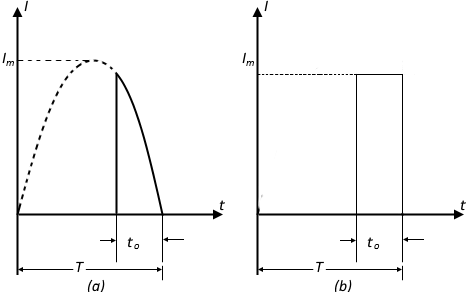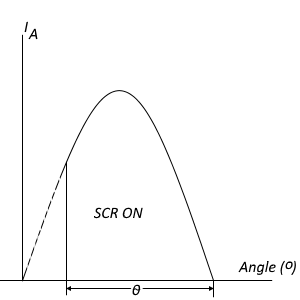SCR Ratings
The ratings of a semiconductor device give the values for the various conditions that a manufacturer recommends for reliable operation of the device. The use of a device beyond the limits defined by its ratings usually leads to destruction. Therefore, a device should never be used beyond its rating limits.
Subscripts for SCR Ratings
Most of the important SCR ratings are given in terms of voltage (V) or current (I). Each rating is accompanied by one, two or three subscriptions, whose meanings are listed in Table 1.
Table 1: Subscript notations
A | Anode or ambient |
AVE | Average |
C | Case |
D | Forward blocking region (no gate voltage) |
F | Forward |
G | Gate |
H | Holding current |
j | Junction |
K | Cathode |
L | Latching |
M | Maximum |
O | Open third terminal (for example, gate open) |
pk | peak |
R | Reverse (when used as the first subscript) repetitive (when used as the second subscript) |
S | Shorted (when used as the first subscript) surge (when used as a second subscript) |
T | Total or maximum (when used as the first subscript) triggered (when used as a second subscript) |
SCR Current Ratings
Maximum Repetitive RMS Current Rating
The forward (anode-to-cathode) current that an SCR can safely carry depends on the maximum junction temperature not exceed its maximum value. It is not cations is that the junction temperature not exceed its maximum value. It is not easy to measure and control T1 directly. However, we can easily measure and control the SCR voltages and currents that contribute to T1. The largest contributor to T1 is repetitive RMS on-state current IT(RMS).
The RMS (or effective) current is used to rate the device, since it determines the heat dissipation. However, the DC or average current delivered to the load is usually more important. Therefore, manufacturers give their data in terms of average current (IT(AVE)), which is called rated average on-state current IT(AVE) is the maximum average current value that can be carried by the SCR in its on state. Average current is equal to RMS current in a pure DC circuit. However, the average value of a pulse is much lower than its RMS value.
Determining the RMS value of a nonsinusoidal waveform like the one shown in Figure 1 is quite difficult. We can simplify the calculations by approximating the nonsinusoidal waveform by a rectangular waveform whose Hight is equal to the peak value and whose width is equal to the pulse duration. This approximation will give a higher RMS value, but it leaves a slight safety factor.

Figure 1: Approximation of the SCR waveform (a) actual waveform (b) approximation After approximating, the RMS value of the current can be found from
Where tO is the pulse, T is the pulse-repetition time, and Im is maximum current. The average value of the pulse is given by
IAVE = Im tO / T
The form factor (fO) is defined as the ratio of the RMS current to the average current.
fO = IRMS / IAVE
Table 2: Conduction angle versus form factor
Conduction angle (θ)
Form factor (fO)
20O
5.0
40O
3.5
60O
2.7
80O
2.3
100O
2.0
120O
1.8
140O
1.6
160O
1.4
180O
1.3
If we know the form factor for a given waveform, the RMS current can be easily obtained from
IRMS = fO ( IAVE )
The given current rating of a SCR is usually its maximum repetitive RMS current (ITRMS). Care should be exercised if the current rating given is DC or average. The RMS rating ITRMS is then.
ITRMS = fO ( IT(AVE) )
Table 2 gives the form factor as a function of conduction angle (θ). The conduction angle is the duration for which the SCR is on. It is measured as shown Figure 2.

Figure 2: Conduction angle measurement Surge Current Rating (IFM or ITSM)
The surge current rating of an SCR (IFM or ITSM) is the peak anode current that an SCR can handle for a brief duration. These durations must be isolated by SCR can handle for a brief duration. These durations must be isolated by enough time for the SCR junction to return to its rated operating temperature. The surge current rating may be five to twenty times as large as the repetitive RMS current rating (IT(RSM)). An SCR is designed to withstand a maximum of 100 surges during its operating life because it may be left with damage due to excessive exposure to high temperatures. To prevent damage to the SCR, the surge current and repetitive current rating should not be exceeded.
Latching Current (IL)
A minimum anode current must flow through the SCR in order for it to stay ON initially after the gate signal is removed. This current is called the latching current (IL). if this current is not reached while the gate signal is being applied, the SCR may turn ON. But it will turn OFF when the gate signal is removed.
Holding Current (IH)
After the SCR is latched ON. a certain minimum anode current is required to maintain conduction. If the anode current is reduced below this critical value, the SCR will turn OFF. The lowest value of current, just before the SCR turns OFF, is the holding current ((IH). Both holding and latching currents decrease when the temperature increases and vice versa. The ratio of the two currents (IH and IL) is approximately 2:1. These values are quite small compared to ITRMS. IH or IL may pose a problem in circuits where the load current is much lower than ITRMS or the SCR is operated at low temperature.
SCR Voltage Ratings
The SCR voltage rating is a measure of the maximum voltage that can be applied across the device without causing a breakdown. The various ratings related to voltage are discussed next.
Peak repetitive Forward Blocking Voltage (VDRM)
The peak repetitive forward blocking voltage (VDRM) is one of the basic SCR ratings. It is the maximum instantaneous voltage that the SCR can block in the forward direction. VDRM is selected to be less than the forward breakover voltage (VFBO), if the VDRM rating is exceeded, the SCR will conduct even without a gate voltage.
Peak Repetitive Reverse Voltage (VRRM)
Like diodes, SCR’s have a peak voltage rating. It is called the peak repetitive reverse voltage rating (VRRM). It is the maximum instantaneous voltage that an SCR can withstand, without breakdown, in the reverse direction.
The VDRM of any SCR is lower than its VRRM. This will automatically satisfy the VRRM rating. If the VRRM rating is exceeded, the SCR is likely to be damage VDRM and VRRM both tend to increase as temperature increases.
Nonrepetitive Peak Reverse Voltage (VRSM)
The nonrepetitive peak reverse voltage rating (VRSM) is the maximum transient reverse voltage that the SCR can withstand. SCR’s can safely block nonrepetitive voltages, so this rating is generally 10 – 20% higher than the repetitive voltage rating. VRSM can be increased by inserting a diode of equal current rating in series with the SCR.
SCR Classification According to Frequency and Switching Speed
SCR’s are classified into two categories that reflect both frequency and switching speed ratings. Slow switching or phase control type SCR’s and fast-switching or inverter-type SCR’s. Phase-control SCR’s have a large turnoff time and therefore have lower frequency. Inverter-type SCR’s must be used in high frequency operations, since the required circuit turnoff time becomes a significant portion of the total cycle time.
Manufacturers provide the ratings associated with speed in terms of the frequency (fmax) at which maximum anode current Imax or maximum power dissipation (Pmax) decreases to zero, turn-on time (tON), and turnoff time (tOFF).
SCR Rate-of-Change Ratings
The Critical Rate of Rise of the On-state Current (di/dt rating)
When the SCR initially conducts, the anode current is concentrated in a relatively small area beside the gate. A certain time is required for the conduction to spread out evenly to cover the whole body. However, if the rate at which the anode current increases is much greater than the rate at which the conduction area increases, the initial small area overheats, and this can destroy the SCR. Manufacturers set a safe value for the rate of change of anode current that their devices can withstand. This value is the critical rate of rise of the on-state current, commonly referred to as the di/dt rating of the device. It is expressed in amperes per microsecond (A / µs).
To prevent damage to SCR’s by a high di/dt value, a small inductance (L) is added in series with the device. Inductance opposes any change in current thus slowing down the rise of anode current. The required inductance (L) can be found from equation below.
L ≥ VP / (di/dt) max
Where
L is inductance (in µH)
(di/dt)max is the rate-of-change-of-current rating of the SCR (in A/µs)
VP is the peak value of the source voltage (in V)
